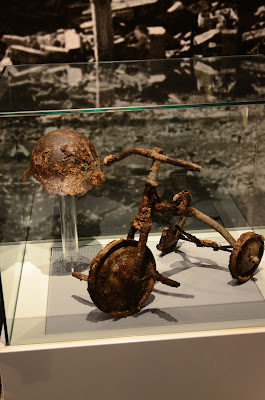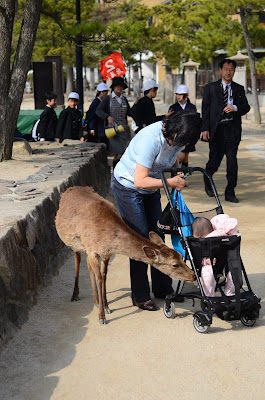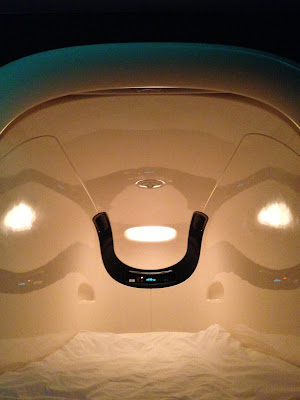Boarded the Sakura service to Hiroshima, again blessed with power and comfy seating, but before that I also managed to spot a rarity at Hakata JR: the elusive Doctor Yellow Shinkansen (basically used for track maintenance operations). A certain Rena would be spazzing out by now...
Hiroshima has a tragic history, being one of the Japanese towns nuked during World War II (the other was Nagasaki, which I already mentioned previously), of which as a result signaled the effective end of the war through the Japanese surrender to the Allied Forces. Over the years following that incident, the city rebuilt itself. Now it thrives as a major economic center in western Japan. Of course, the city (and its past) has generated much tourism interest, leading to the sprawling tourist crowd I witnessed throughout Hiroshima.
Getting around is, again, fairly easy thanks to its developed (and yet another) tram system. Flat fare of 150¥.
First stop was the famous Hiroshima Peace Park and adjacent Atomic Bomb Memorial site. The A-Bomb Dome was still intact.
Lots of paper crane memorials made by students and organisations from across the world, hung around the compound and on display.
This was the main memorial cenotaph site for the Hiroshima victims.
Inside the museum, you go through the history of Hiroshima, both before and after the atomic bombing. Lots of preserved relics and accounts on display, along with a heavy anti-nuclear and pro-pacifist theme; the entire experience sometimes grueling and often emotional.
As you'd expect, plenty of overseas tourists (especially from the West - Australia had lots of representation that day) and Japanese school student groups on excursion. In fact, there was this bunch of (Sydney-based, I'm guessing) school girls on tour; clearly noticeable not just from their accent but their typical Aussie high school character. (Go watch some Summer Heights High - okay, maybe not that private-school pretentious but the rest is all there...).
After that somewhat reflective and emotional experience, it was time for food. Hiroshima is famous for its own style of okonomiyaki - instead of mixing everything at once on the iron grilling plate, they stack their ingredients on top of each other and press it all down flat. In fact, Hiroshima has an entire building (Okonomi-mura) dedicated to just okonomiyaki, with dozens of different vendors vying for your presence.
Since it was getting into mid-afternoon and, having checked the tide times earlier in the day, the high tide was approaching, I decided to head to Miyajima - a 20-25min train trip from Hiroshima, and another 10min (JR pass covered) ferry ride to Miyajima island itself.
And for some odd coincidence of timing, the aforementioned Sydney-sider school girls were also onboard my ferry. Some irreverently humming Western pop tunes. And me covering my ears (okay, not literally) in horror and annoyance.
Miyajima is quite a nice, if touristy, island. Apart from the obvious floating torii gate (which 99% of people arriving here came to see), it has a fairly large shrine and plenty of roaming deer - the latter which I didn't expect (I originally thought that they were only unique to Nara. Apparently not).
The island is also famous for its oysters - unfortunately, I was still a little full and only intended to try out another famous snack: the momiji manju. I bought both a fried variant and the normal baked one.
Pretty much just flour-based wagashi filled with various kinds of pastes and creams, depending on the flavour. I chose red bean and matcha respectively.
It was getting late, so I went back to Hiroshima to board the next Shinkansen to Shin-Osaka, and onwards to Kyoto, where I'd be staying for the night. Interesting vending machine at Miyajima station: an instant coffee machine (brewed coffee on the spot, not your average canned type). Can't vouch for quality, as I didn't try it out.
What happened afterwards at Hiroshima JR was a bit of a strange but close, and lucky, call. Normally, with my luggage, because of my risk-averse tendencies, I usually go and reserve seating tickets if I'm lugging luggage around. I went and did just that, but for some really odd reason, the next Sakura departure had all its reserved seating booked out, so they put me on the following train - which wasn't scheduled to arrive until at least an hour later after the next one. That put my (dinner) plans back significantly, as I wouldn't be at Kyoto until 9pm the latest. So I decided to forego my ticket reservation and headed straight for a non-reserved seat on the next Sakura service. Thankfully, they still had some seats and luggage space at the rear of the carriage - and more importantly, window seats (i.e. power outlets). Managed to arrive at Kyoto around 8pm, giving me enough time to store my luggage in a coin locker before I headed out to dinner.
Dinner was at a place famous for its different omu(lette)-rice dishes. Feeling a bit peckish, I went for the prawn.
Unfortunately, the street (along the canal) nearby where I ate was a little suss. Plenty of bars and hostess bars around at night, with suss looking gangsters and ushers looking to get you in for some happy time. Didn't quite help that when I was looking for the restaurant, it was tucked away into those narrow Kyoto lanes that you easily miss when walking by.
Afterwards, I was feeling a bit desperate. In fact, during the entire day, besides the aforementioned spots I visited, I constantly searched up nearby bookstore vendors throughout Hiroshima and Kyoto. Why? I wanted to see if Mayu Watanabe's latest photobook would be out "furage" ("flying get" i.e. released the day/s before the official release date), as I saw online that day that it was already out in some stores. Unfortunately, most stores in this part of Japan didn't have it available yet, including in one large Tsutaya at Kyoto that I visited after dinner. Hopes dashed, and night wasted, I went back to Kyoto station and proceeded to my accommodation for the evening.
Afterwards, I was feeling a bit desperate. In fact, during the entire day, besides the aforementioned spots I visited, I constantly searched up nearby bookstore vendors throughout Hiroshima and Kyoto. Why? I wanted to see if Mayu Watanabe's latest photobook would be out "furage" ("flying get" i.e. released the day/s before the official release date), as I saw online that day that it was already out in some stores. Unfortunately, most stores in this part of Japan didn't have it available yet, including in one large Tsutaya at Kyoto that I visited after dinner. Hopes dashed, and night wasted, I went back to Kyoto station and proceeded to my accommodation for the evening.
Unfortunately, unlike every other major city in Japan, Kyoto's subway system isn't forgiving if you're hauling around luggage. With no escalator or elevator in sight at each station, you're relegated to heavy lifting up and down flights of stairs. No fun for my arms and legs.
Eventually, after flights of stairs and a long street, I arrived at my accommodation for the night. A capsule hotel.
But this was no ordinary capsule hotel. It boasted one of the most minimalist and futuristic designs I've seen. Slabs of white and grey, wordless signage and super clean decor made for one of my more unique accommodation experiences.
Upon check-in, you dump your luggage at the lobby (it's staffed and, considering this is Japanese politeness and courtesy we're talking about, generally pretty secure, common sense notwithstanding) - which most salarymen checking in for a quick slumber won't have anyway - place your shoes in the shoe locker and take the lift up to your gender segregated floors.
The changing room floor has your own locker to put smaller bags and other valuables in, and supplied yukata, towels and other toiletries. You change and then go take a shower (or bath); they have some really fancy organic toiletries on offer, like "darjeeling tea shower gel". Afterwards, you go down to your designated floor where your capsule "pod" awaits.
You won't feel claustrophobic here, but it's mainly designed for one thing: sleep. No TV, not even a personal aircon (but there's sufficient ventilation), although there is a power outlet for your phone charger. Only a privacy blind and the curvature of the white walls separates you from the outside world, so earplugs are encouraged. Be aware there isn't much in the way of storage space - enough for your locker keys and phone, but that's about it. All it has is an overhead light and a sleep timer, which controls the overhead light.
There are instructions on how to set the timer, but once you have done so and activated it (when you begin to sleep), the softly glowing yellow light starts to slowly (and I do mean slowly) fade away, in accordance with how people normally drift off into sleep. When it's time to wake up, the light glows a cool, bright white. No alarms or music, just the simple use of light. It's all very space-age and highly minimalistic, but effective in its job to get you to sleep and wake up on time.
Breakfast: Chocolate muffin
Canned coffee of the day: Suntory BOSS Cafe au lait (giant bottle)



































No comments:
Post a Comment